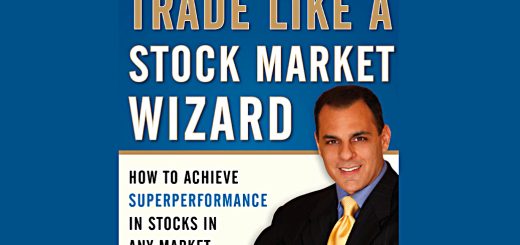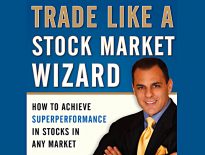Mark Minervini 1 – Specific Entry Point Analysis (SEPA®)

Today’s post is our first visit to a popular investing book – Mark Minervini’s “Trade Like A Stock Market Wizard”.
Contents
Mark Minervini
Mark Minervini is a trader with 30+ years experience. (( He started a year before I did ))
- For the first six years he lost money.
He likes the quote from Bill Gates that most people “overestimate what they can achieve in the short run and underestimate what they can accomplish over the long haul.”
Prepare, prepare, prepare, because when opportunity knocks, which it definitely will, you want to be there to answer the door.
Inspired by David Ryan – who won three consecutive U.S. Investing Championships, posting triple-digit returns every year – in 1997 Minervini entered and won the US investment championship.
- Using only a long stocks portfolio, he managed a 155% annual return.
His system is known as SEPA® – Specific Entry Point Analysis – and his biggest influence is Richard Love, who wrote the book Superperformance Stocks.
- Over five years he traded his system to 220% compound average returns with just one losing quarter.
- This would turn £1K into £300K.
Minervini featured in Jack Schwager’s book Stock Market Wizards, and his own book is called How to Trade like a Stock Market Wizard. (( I hope Jack was OK with that )).
- He also runs the inevitable trading programs and has in the past provided institutional research.
Minervini appears regularly on TV in the States, but I have so far managed to avoid ever seeing him.
- But his book comes highly recommended, so let’s get started.
Foreword
Winning stock traders share certain key traits required for success. Fall short in those qualities and you will surely part ways with your money. The good news is that you don’t have to be born with them.
The two things that Minervini thinks that you have to learn are:
- effective trading tactics
- the necessary mindset and emotional discipline
Two things are required: a desire to succeed and a winning strategy.
The stock market provides incredible opportunity … New companies are constantly emerging … I’m going to tell you how to develop the expertise to find your next superperformer.
Mark spends a fair bit of the foreword selling the idea that anyone can do this.
- Education isn’t needed, as Mark left school at 15.
But he has read more than 1,000 investment books.
- And he did practice for years without success.
He wants you not to let others discourage you.
Surround yourself with people who encourage you and don’t let the naysayers knock you off track.
He also says that it’s not about the money – the best traders simply want to be good at trading.
- Concentrate on being the best trader you can be, and the money will follow.
But remember you need to get real-life experience, not just read about trading.
- You have to get started – and the best time to start is today.
Trading style
Mark describes his approach to trading as being “a conservative aggressive opportunist”.
- That means he aggressively pursues profits but is also very risk-conscious.
- He looks at how much he could lose as well as how much he could win.
- He’s quite prepared to cash out before a bear market (he claims to have done this eight times).
To realize profits from investing in stocks, you must make three correct decisions: what to buy, when to buy, and when to sell.
Not all of your decisions will turn out to be correct, but they can be intelligent. My goal is to assist you in making these decisions.
What you need to know
Before introducing his own system, Mark presents a chapter on more general market lessons.
Few individuals truly believe they can achieve super performance in stocks. They’ve been told that a big return entails big risks or that if it sounds too good to be true, it probably is.
Mark is back to his “anyone can do it” message – you just have to practice.
Long-term success in the stock market comes from discipline, the ability to consistently execute a sound plan and refrain from self- defeating behavior.
He compares stock trading to surgery – the odds are stacked against amateurs, but:
To a trained surgeon with the necessary expertise, it is a job with risks that are offset by knowledge, training, and skill.
Mark also reassures readers that they can start small.
Mark thinks that the stock market is still driven by emotions – It’s Not Different This Time.
Your greatest challenge is not the stock market. It’s you.
Mark is a big fan of the DIY approach.
If you aren’t prepared to invest a good portion of your time before you invest, you’re just throwing darts.
No one cares about your money and your future as much as you do.
Mark says that it’s more important to make money than it is to be right.
- You should cut your losses, and let your winners run.
I began selling off losing stocks quickly, which meant taking small losses but preserving the lion’s share of my hard-earned capital. Almost overnight, I regained a feeling of control.
Practice does not make perfect. Only perfect practice makes perfect. – Vince Lombardi
What you need to do is make sure that you are practising the right things.
Mark is not a fan of paper trading, since it can’t prepare you emotionally.
It’s like preparing for a professional boxing match by only shadowboxing; you won’t know what it’s like to get hit until you enter the ring with a real opponent.
Start to trade with an amount of money that is small enough to lose without changing your life but large enough that losses are at least somewhat painful.
Mark makes the analogy that trading is like running a business.
Your merchandise is stocks. Your objective is to buy shares that are in strong demand and sell them at a higher price.
In the end, it all comes down to having your gains on average be larger than your losses.
A professional money manager has no advantage over an individual investor.
Mark’s (and my) view is that you should become a DIY investor.
If you want mutual fund-like results, invest like a fund manager. If you want superperformance results, you must invest like a super performance investor.
Mark is also a contrarian, to the extent that he doesn’t follow the textbook theories.
A sound banker is not one who foresees danger, but one who is ruined in a conventional way along with his fellows, so that no one can blame him. –John Maynard Keynes
Attaining super performance comes from doing things that are different from what is obvious or popular. This is often misinterpreted as risky.
If you want to be the best, you have to do things that other people are unwilling to do. –Michael Phelps
Mark believes in specialisation – as in the medical profession – over being a jack-of-all-trades.
I fear not the man that has practiced 10,000 kicks once, but the man that has practiced one kick 10,000 times. –Bruce Lee
He accepts that this means that there will be parts of the market cycle where you will underperform.
I know no one who can successfully trade value in one cycle and then switch to growth the next or be a long-term investor one day and then a day trader to suit the market du jour.
This includes time-horizon – are you a trader or an investor?
Towards SEPA®
In Chapter 3, Mark introduces his winning system (SEPA).
- But first he explains his losing strategy from the 1980s.
When stocks were trading near their historical lows, I figured they had to be bargains. It wasn’t long before I realized that many of these stocks were low-priced for good reason and in most cases were on their way to lower lows.
He also noticed that many stocks on the 52-week-high list went even higher.
Influences
Mark was influenced by Richard Love’s book Superperformance Stocks.
- Chapter 7 looked at what big winning stocks had in common.
- Love focused on stocks that went up 300% or more, and covered the period between 1962 to 1976.
Then in 1988, Mark read an article in the Financial Analyst Journal by Marc R. Reinganum called “Anatomy of a Stock Market Winner.”
- This study looked at stocks that went up 100% during the period from 1970 to 1983.
Cross-referencing the two, Mark became convinced that this “reverse factor modeling” had merit, with two key lessons:
- There is a right time and a wrong time to buy stocks.
- Super performance stocks are identifiable before their dramatic price increase.
Mark also cites “The Relative Strength Concept of Common Stock Price Forecasting” by Robert A. Levy.
- This helped him to focus on price strength.
And he liked Edward S. Jensen’s “Stock Market Blueprints” for each type of stock (income, growth, cyclical growth, and dynamic growth).
He also liked trend following rules.
And William L. Jiler’s work on chart patterns was also influential.
- The cup-and-handle patter popularised by William O’Neil was his favorite.
His final influence was Jesse Livermore, and his lesser-known book “How to Trade in Stocks”.
The leadership profile
When computers became cheap enough to have at home (late 1980s, kids), Mark worked all this information up into what he calls The Leadership Profile.
- This is a blueprint of what makes a super performance stock.
- Mark compares all stocks with this to see how well they match.
Specific Entry Point Analysis (SEPA®)
Once he knew what kind of stocks he was looking for, Mark focused on timing his entries and exits.
He was looking for high-probability entries with good risk-reward ratios.
When he had this worked out, the SEPA system was born.
The system has five elements:
- Trend
- More specifically, price uptrend
- Fundamentals
- Superperformance stocks (superperformance phases in stocks) are driven by better earnings, revenue, and margins.
- This improvement usually starts before the superperformance phase, but continues within it.
- Catalyst
- The big winners have a catalyst which drives institutional interest.
- This could be a drug approval, a new product or a big contract, or a new CEO.
- He cites Blackberry, Apple and Google as examples.
- Entry points
- Mark doesn’t explain here how to find these, but simply states that most super performers have at least one low-risk entry point.
- Exit points
- Not all trades will work out.
- So you need a stop loss to force you out of losing positions in order to protect your account.
- You also need to identify the end of the super performance stage in order to sell at a profit.
- Mark doesn’t tell us how to do this here.
SEPA® ranking process
Mark also provides an overview of his process:
- Stocks must satisfy a Trend Template
- A series of filters based on earnings, sales and margin growth, relative strength, and price volatility are then applied.
- 95% of trending stocks will fail the filters.
- Those that pass are matched against the Leadership Profile
- This includes both fundamental and technical factors
- The final stage is a manual review, using the following characteristics:
- Reported earnings and sales
- Earnings and sales surprise history
- Earnings per share (EPS) growth and acceleration
- Revenue growth and acceleration
- Company-issued guidance
- Revisions of analysts’ earnings estimates
- Profit margins
- Industry and market position
- Potential catalysts (new products and services or industry- or company-specific developments)
- Performance compared with other stocks in same sector
- Price and trading volume analysis
- Liquidity risk
The process is designed to identify potential for:
- Future earnings and sales surprises and positive estimate revisions
- Institutional volume support
- significant buying demand
- Rapid price appreciation based on a supply/demand imbalance
- lack of selling vs buying
This is all to find the “Probability Convergence” – the point with the lowest risk and the highest potential for reward.
My goal is to purchase a stock and be at a profit immediately.
Superperformance traits
Mark ends the chapter with some of the common traits of superperformance stocks that he has identified:
- Decent earnings are usually already on the table
- Most stocks had fundamental and technical outperformance before their biggest gains
- Coming out of a bear market or correction
- More than 90% of big winners began their surges here.
- Very few stocks super performed during a bear market.
- Less than 10 years into their stock-market listing
- They could have been private companies for many years before their IPO.
- You mustn’t shy away from names you have never heard of.
- Most super performers are small to medium firms
- Sometimes a large cap will super perform as a turnaround, or after a bear market, but Mark would take profits more quickly here.
- Look for smaller firms that are in their growth phase (accelerating earning and sales).
- They should be already profitable and have proved that their business model can be scaled.
Stock Screening
Mark uses stock screens, but he cautions against making them too complicated.
You may inadvertently eliminate good candidates that meet all your criteria except for one.
He likes to run several screens that are based on smaller lists of compatible criteria.
- So there would be a screen for relative price strength and trend.
- And a separate fundamental screen based on earnings and sales.
Some names will recur, while others will appear on only one list.
Conclusions
We’ll leave it there for today.
- We’ve covered three out of thirteen chapters.
It’s a relatively long book for an investing manual, and I think it’s unlikely that we’ll cover it in our usual four articles.
- Five or six seem more likely at this stage, but we’ll see how it goes.
This is a very American book, with a lot of emphasis on determination and self-belief.
- But what we’ve covered of the system so far seems reasonable.
It reminds me of Weinstein’s Stage System, but with a layer of fundamental analysis added on top of the technicals.
- I’ll be back in a few weeks with the next couple of chapters, which cover Value and Trend.
Until next time.

















Simply, Awesome! I just loved the way you have written the book summary.
Thanks a lot.
This is great and saves a lot of time. Thanks a lot!